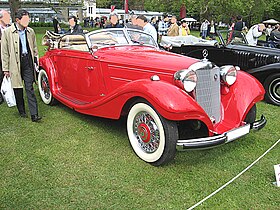Mercedes-Benz W142
| Mercedes-Benz W 142 | |
|---|---|

Mercedes-Benz Typ 320 (W142/I) 2-door longer-wheelbase “Cabriolet A” (1938)
|
|
| Overview | |
| Manufacturer | Mercedes-Benz |
| Also called | Mercedes-Benz Typ(e) 320 Mercedes-Benz W 142/I (shorter wheelbase) Mercedes-Benz W 142/II (longer wheelbase) Mercedes-Benz W 142/III (shorter-wheelbase “Kübelwagen” for military use) ) Mercedes-Benz W 142/IV |
| Production | 1937–1942 7,017 units |
| Assembly | Stuttgart, Germany |
| Body and chassis | |
| Class | Large luxury car |
| Body style | Shorter wheelbase: 3-seater Cabriolet Coupé with removable roof Longer wheelbase: 4-door ”Limousine” (sedan) 4-door ”Pullman-Limousine” (“six-light” saloon/sedan) Torpedo-bodied 6-seater “Tourenwagen” 2 & 4-door Cabriolets (various) 6-seater Pullman- Cabriolet Roadster ”Stromlinien-Lmousine” (sedan/saloon) with a particularly streamlined body) |
| Layout | FR layout |
| Powertrain | |
| Engine | 1937–38: 3,208 cc I6 1938–42: 3,405 cc I6 |
| Dimensions | |
| Wheelbase | 2,880 mm (113 in) or 3,300 mm (130 in) |
| Length | 4,700 mm (190 in) - 5,250 mm (207 in) |
| Width | 1,630 mm (64 in) |
| Height | 1,580 mm (62 in) |
| Chronology | |
| Predecessor | |
The Mercedes-Benz W 142 was a six-cylinder passenger car launched in February 1937, as a successor to the Mercedes-Benz Typ 290 (Mercedes-Benz W 18). The car was launched using the name Mercedes-Benz Typ 320, but is in retrospect commonly referred to using its Mercedes-Benz works number, "W142" which gives a more unambiguously unique nomenclature.
The standard-wheelbase version of the W142 shared its 2,880 mm (113 in) wheelbase with the standard lengthened versions of its predecessor, but a more streamlined form with longer overhangs meant that even in this form the W142 was substantially longer and indeed wider than the earlier car. The front grill was gently raked backwards, and there was no longer a bar in front of it to carry lights, all of which gave the car a more sporting look than the model it replaced.
Power came from a newly enlarged straight six 3,208 cc side-valve engine with a listed maximum output of 78 PS (57 kW; 77 hp) at 4,000 rpm, supporting a claimed top speed of 130 km/h (81 mph). This was delivered to the rear wheels via a four-speed manual transmission which, unusually in the 1930s, incorporated synchromesh on all four ratios. The footbrake used a hydraulic control mechanism and operated on all four wheels. The suspension set-up was carried over from the W18 with a swing axle at the rear and the front axle suspended with a central transverse leaf spring and coil springs beside the wheels.
Customers wishing to make their own arrangements in respect of bodywork could buy a standard-wheelbase W142 in base chassis form at the manufacturer's listed price of 6,500 Marks. Otherwise the choice of standard bodies was restricted to a three-seat cabriolet (known as the "Cabriolet A") or a coupé-bodied equivalent with a removable roof, priced respectively at 11,800 Marks or 12,300 Marks.
Longer-bodied cars came with an extra 420 mm (17 in) of wheelbase, and Mercedes-Benz offered a choice from a wide range of standard body options for the longer cars.
Customers happy to make their own arrangements in respect of bodywork could buy a longer-wheelbase W142 in base chassis form at the manufacturer’s listed price of 6,800 Marks, or 300 Marks more than the price of the shorter chassis. The entry level model with a Mercedes-Benz body included in the price was the four-door ”Limousine” (sedan/saloon) at 8,950 Marks. There were no fewer than four cabriolet-bodied versions of the longer-wheelbase car offered, being a two-door 2/3-seater ("Cabriolet A"), a two-door 4-seater with four side-windows ("Cabriolet B"), a four-door 4-seater ("Cabriolet D") and a very substantial-looking four-door 6-seater with three rows of seats ("Pullman-Cabriolet F"). Other soft-topped standard-bodied versions were a Torpedo-bodied 6-seater "Tourenwagen" and a sporty 2-seater Roadster. There was also a six-seater “Pullman-Limousine” with three rows of seats and six side windows under a conventional steel roof. The rear seat of the Pullman-bodied cars was above the back axle, and an extra luggage locker at the back left the overall length of the Pullman-Limousine at 5,250 mm (207 in), still using the 3,300 mm (130 in) wheelbase. The highest listed price for a Mercedes-Benz-bodied W142 was 14,500 Marks for a "Stromlinien-Limousine" featuring a strikingly modern exceptionally streamlined steel body.
...
Wikipedia
